
Les communautés professionnelles ont la côte en ce moment. Et pour cause, elles peuvent avoir un impact considérable au sein d’une organisation. Cependant, il n’est pas toujours évident de savoir comment la lancer pour la rendre attractive et pérenne.
Il existe de multitudes de manières de faire et comme toujours, elles sont contextuelles. Je vous en propose une dans cet article, à prendre avec les réflexions associées bien sûr ! 😉
Contexte

La mise en oeuvre d’une communauté n’est pas anodine. C’est d’autant plus vrai lorsque la culture de la production, c’est-à-dire de délivrer le plus possible, est particulièrement ancrée. En effet, la vocation première d’une communauté est de créer un espace d’apprentissage entre pairs ce qui apparaît souvent comme une perte de temps, car non « productive ».
Dans mon cas, l’idée de la création d’une communauté a émergé lorsqu’a été remis en question un comité de transformation Agile hebdomadaire. Ce dernier, réunissant des membres du comité de direction, l’équipe de facilitation et quelques volontaires avait pour but initial de soutenir l’appropriation Agile dans l’entreprise. Cependant, il commençait à battre de l’aile et à se transformer en réunion de reporting. Une des raisons était probablement le manque de focus et d’intention claire. Et comme on le sait, les habitudes reviennent vite au galop ! 😉
Ma proposition fut alors de transformer ce comité en 2 événements bien distincts :
- Un comité Agile de prise de décision : pour focaliser et actionner la transformation d’entreprise. Il réunirait le comité de direction et l’équipe de facilitation
- Une communauté Agile transverse : pour créer un espace d’ouverture, de partage et d’entraide. Il réunirait un ensemble de profils variés.
C’est ce second événement qui sera décrit par la suite.
Conception

Pour la conception du Kick-off de communauté, je me suis appuyé sur mes collègues Eugénie et Florian qui allaient animer avec moi. En effet, l’animation allait se faire à distance et au vu du nombre de personnes attendues, j’aurais besoin d’aide. De plus, il me paraissait important de co-construire avec eux pour que cet événement soit aussi le leur ! 🙂
Nous décidons alors de partir sur un canevas 7P pour mieux visualiser notre atelier :
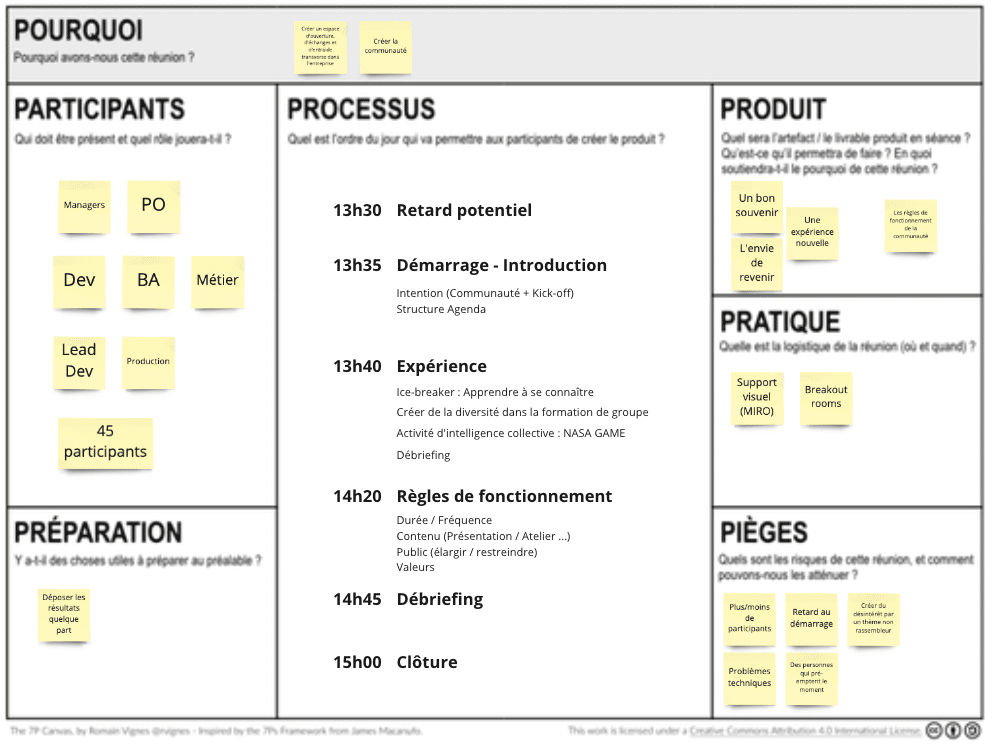
Purpose / Pourquoi
| Réponse collective | Commentaires |
| – Créer un espace d’ouverture, d’échanges et d’entraide transverse dans l’entreprise – Créer la communauté |
Product / Produit
| Réponse collective | Commentaires |
| – Un bon souvenir, l’envie de revenir, une expérience nouvelle – Les règles de fonctionnement de la communauté | – Il y a donc un aspect expérientiel important à prendre en compte en même temps qu’un aspect structurel. – La question qui se pose est la suivante : est-ce que l’on pose les règles de la communauté en premier (moins marrant mais structurant) ou plutôt la partie expérientielle (plus ludique) ? -> Le choix s’est porté sur l’expérience pour créer l’ambiance afin de définir les règles communes par la suite. |
Participants
| Réponse collective | Commentaires |
| – Managers, PO, Dev, BA, Métiers, Production – 45 participants | – Nous avons le terreau de diversité, à nous de faire que les personnes qui se connaissent ne se mettent pas ensemble automatiquement. – Un sous-groupe de plus de 6-8 personnes me semble compliqué à gérer pour permettre l’interaction de chaque membre. Ainsi au maximum nous aurions 6 équipes -> ok avec un animateur pour 2 équipes. |
Préparation
| Réponse collective | Commentaires |
| – Support Miro où déposer les résultats |
Practical Concerns / Logistique
| Réponse collective | Commentaires |
| – Logistique Miro : accès, manipulation de base – Salles Teams : séparation en sous-groupes | – Normalement, toutes les personnes invitées ont été sensibilisées à l’outil Miro mais on ne sait jamais. – Plutôt que de devoir gérer la répartition dans les breakout rooms, mieux vaut créer des salles et laisser les personnes les rejoindre directement. – Il faudra juste bien prendre en compte le temps de latence de démarrage et de retour en salle principale. |
Pitfalls / Risques
| Réponse collective | Commentaires |
| – Plus ou moins de participants – Retard au démarrage / arrivée tardive – Problèmes techniques – Des personnes qui pré-emptent l’événement – Créer du désintérêt par un thème non rassembleur | – Le nombre de participants va influer sur le nombre d’équipes, avec 6 équipes on devrait être bon. – On place un buffer de 5 minutes le temps que les personnes se connectent mais on commencera l’introduction par la suite. – Je serai l’animateur principal. Florian et Eugénie pourront ainsi m’aider à gérer la logistique pendant que je cadrerais le contenu. – À nous de nous assurer que les conversations sont les bonnes et que chacun ait l’occasion de s’exprimer. Nous avons le mandat sur le cadre ! – Il nous faut trouver un thème simple qui permettrait à chacun de contribuer, la réflexion collective semble être adaptée. -> Je propose de partir sur un Nasa Game, qui répondrait bien à notre besoin et qui serait simple à animer à distance (moyennant préparation du support visuel). |
Processus
| Réponse collective | Commentaires |
| 13h30 Retard potentiel 13h35 Démarrage – Introduction – Intention (Communauté + Kick-off) – Structure Agenda 13h40 Expérience – Ice-breaker : Apprendre à se connaître – Diversity Index – Nasa Game 14h20 Règles de fonctionnement – Durée / Fréquence – Contenu – Public – Valeurs 14h45 Débriefing 15h00 Fin | – En introduction, on veut donner l’impulsion en recontextualisant l’idée derrière cet événement pour lui donner du corps et du sens. On veut également expliquer la spécificité de cette première session qui va nous permettre de mettre les bases pour la suite. – Choix de l’ice-breaker : on souhaitait quelque chose qui ne prendrait pas trop de temps, qui ferait participer tout le monde en même temps et permettrait la visualisation rapide de l’information. On a donc choisi de partir sur un mode Constellation. -> On partira sur 9 questions pour avoir suffisamment de variété pendant une petite quinzaine de minutes. – J’ai proposé d’utiliser la Diversity Index Card pour se donner une idée de la diversité des équipes. C’était plus un prétexte de conversation permettant de sortir un peu du contexte boulot et apprendre à se connaître sous un autre angle. – Concernant les règles de fonctionnement, on va procéder de la même manière que pour les constellations en préparant les choix et en demandant aux participants de se positionner. Cela permettra ainsi de voir rapidement les tendances. – Enfin un débriefing de la session ensemble pour voir si l’on a pu atteindre nos objectifs et que le moment a bien eu l’effet escompté ! 🙂 |
Voyons ensemble ce qu’il s’est passé, au coeur de l’action ! 😉
Animation

Une dizaine de minutes avant l’heure, nous nous assurons que tout est bien opérationnel. Nous pouvons accueillir tranquillement les participants qui arrivent.
Introduction
J’annonce que nous démarrerons bien à 13h35 et que les retardataires nous rejoindront par la suite. Je rappelle ensuite le contexte et présente les intentions de la session, l’équipe d’animation puis l’agenda.
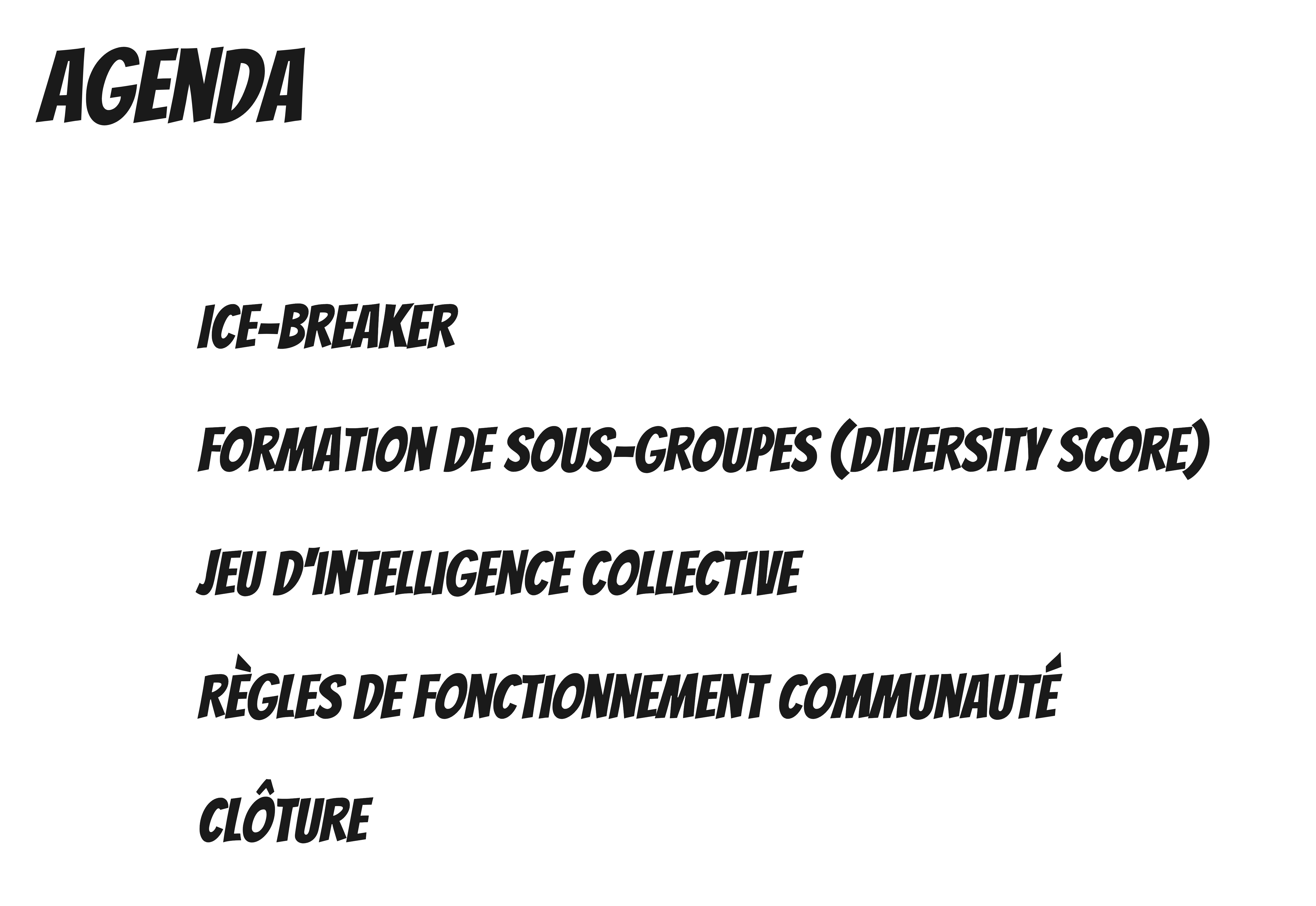
Ice-breaker
On peut alors commencer avec l’ice-breaker. Avant de lancer les hostilités, je rappelle rapidement les règles de fonctionnement. À chaque sujet, une seule réponse possible. Ainsi, on demandera à chaque personne de se positionner avec un post-it nominatif à l’endroit correspondant.
L’exercice se déroule de manière plutôt fluide. À chaque thématique, on entend des réflexions sur le ton de la blague, l’ambiance est bonne ! 😉
Les thématiques abordées étaient les suivantes :
| QUESTION | OPTIONS |
| Quel est votre lieu de naissance ? | France (Nord, Sud, Est, Ouest) / Ailleurs (à préciser) |
| Un sport de prédilection ? | Oui (Indiquer lequel) / Non |
| Nombre d’années dans l’entreprise ? | Moins de 2 ans / Entre 2 et 5 ans / 6 ans et plus |
| Instrument de musique ? | Oui (Indiquer lequel) / Non |
| Thé, café ou aucun des deux ? | Thé / Café / Aucun des deux |
| Une préférence de resto ? | Burger King (Fast food) / L’eau vive (Vegan) / L’adress (Gastronomique) |
| Montagne ou Plage ? | Montagne / Plage |
| Jeux vidéos ou Jeux de société ? | Jeux vidéos / Jeux de société |
| Boisson sans alcool ou avec alcool ? | Sans alcool / Alcool |
Voici le résultat obtenu :
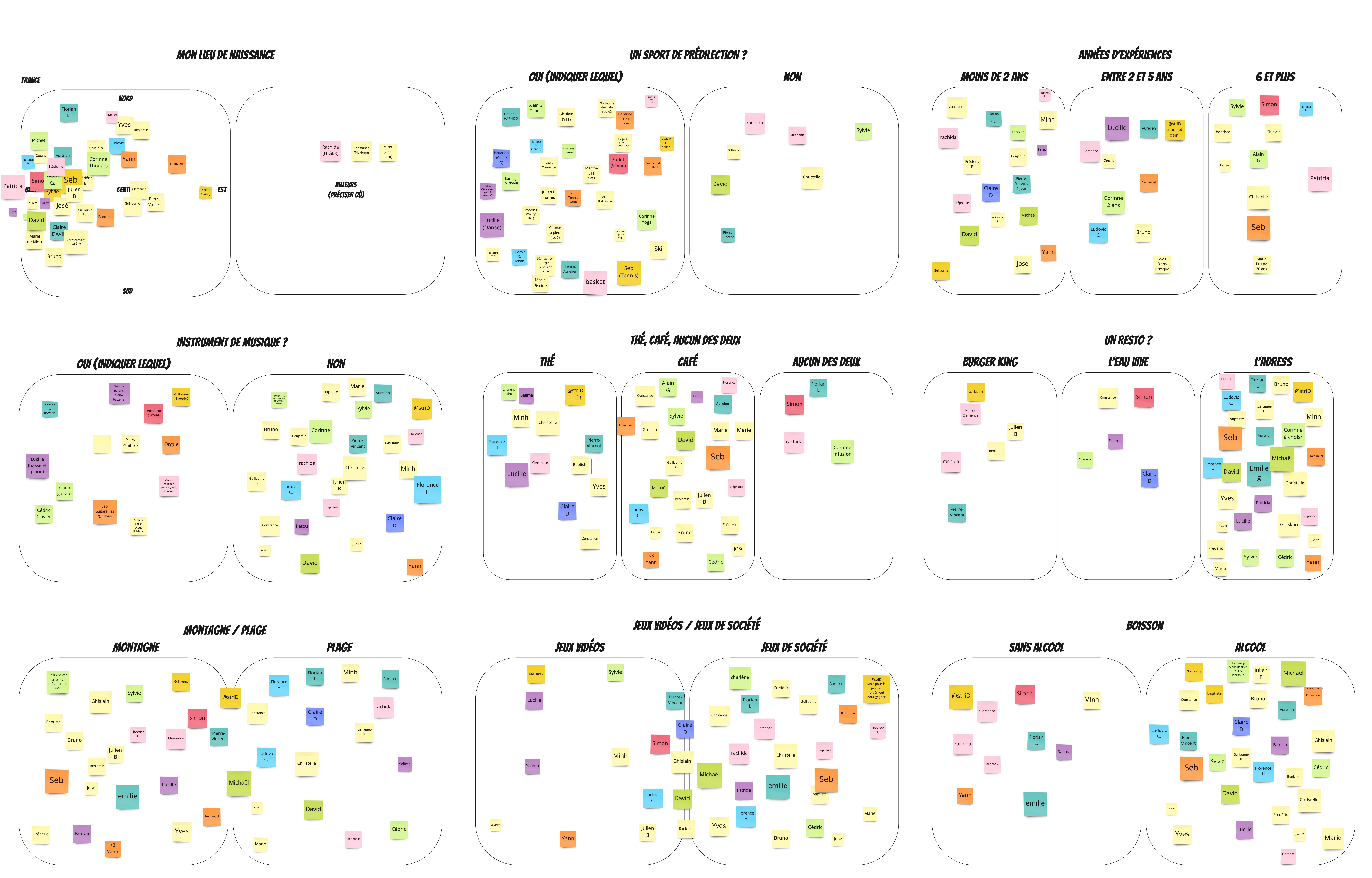
Diversity Index Card
Ensuite, on demande aux participants de se répartir dans les 6 équipes suivantes : Falcon Heavy, Saturn V, Energia, Long March 9, Space Launch Systems, Starship. Vous l’aurez compris, on prepare le contexte pour l’activité qui va suivre ! De plus, on les invite à se regrouper avec des personnes qu’ils ne connaissent pas, une bonne occasion de créer de nouveaux liens ! 😉
Lorsque toutes les équipes sont formées, ses membres se rejoignent sur leur canal Teams dédié.
À présent, chaque équipe va devoir remplir la carte de diversité suivante :
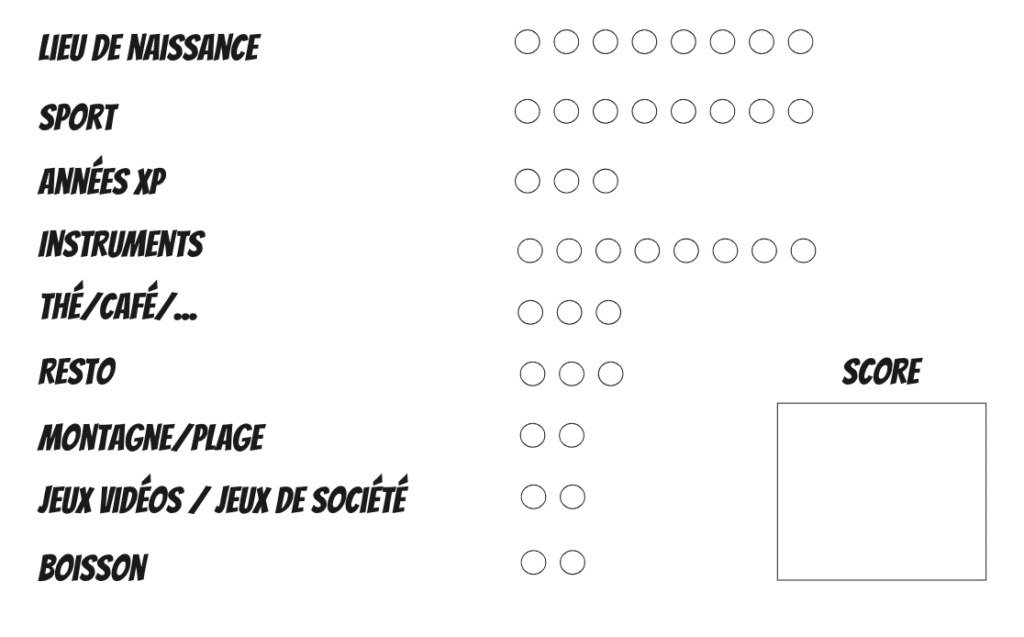
Avec le recul, je pense que l’on aurait pu rajouter une thématique autour du département de chaque personne. Une manière de renforcer l’aspect divers de la composition d’équipe.
Elle a bien évidemment été conçue à partir des thématiques de l’ice-breaker pour rester cohérente. Un prétexte supplémentaire pour créer des échanges informels.
Dans cette séquence, notre rôle est principalement de faciliter les échanges au sein des équipes.
Voici un exemple de Diversity Index Card remplie :
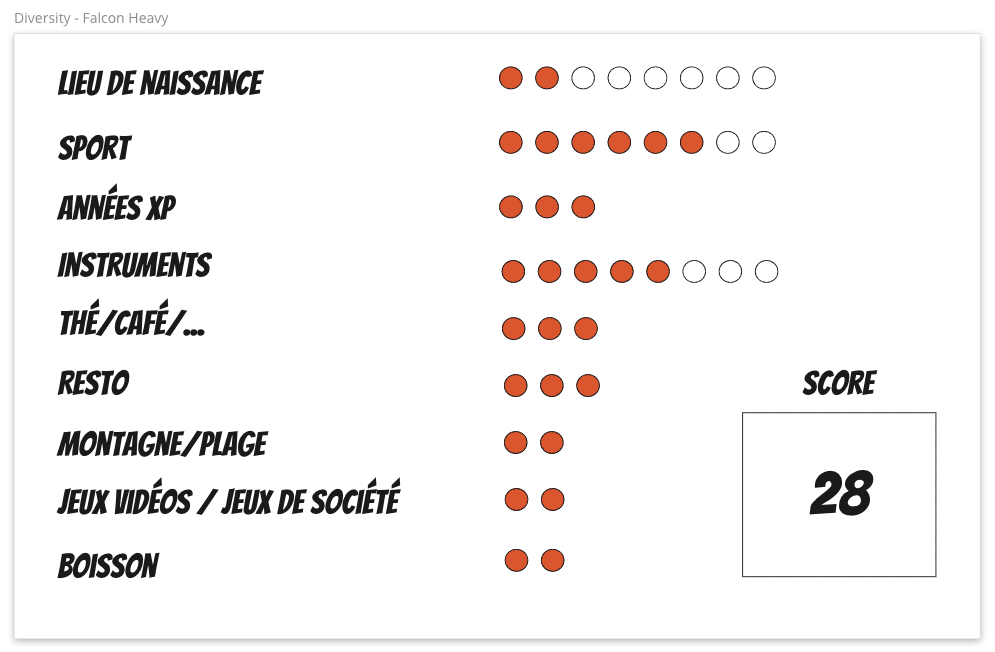
Maintenant que les équipes sont construites, il est temps de les laisser décoller vers la lune ! 😉
Nasa Game
Pitch
Vous faites partie de l’équipage d’un vaisseau spatial programmé à l’origine pour rejoindre une fusée mère de la face éclairée de la lune. A la suite d’ennuis mécaniques, vous avez dû alunir à 320 km environ du rendez-vous fixé. Au cours de l’alunissage, la plupart des équipements de bord a été endommagé, à l’exclusion des 15 objets ci-dessous. Il est vital pour votre équipage de rejoindre la fusée mère et vous devez choisir l’équipement indispensable pour ce long voyage.
Pitch – Nasa Game
L’objectif de chaque équipe est donc de classer les 15 objets du plus important au moins important pour leur quête.
Au vu du temps disponible et de nos intentions, nous ne ferons pas toutes les étapes de l’activité. En effet, nous allons directement demander un résultat collectif à chaque équipe que nous allons comparer au résultat de la NASA. Habituellement, avec un peu plus de temps, cette activité peut commencer par un tour de réflexion individuelle.
Pour cela, ils ont à leur disposition le tableau suivant :
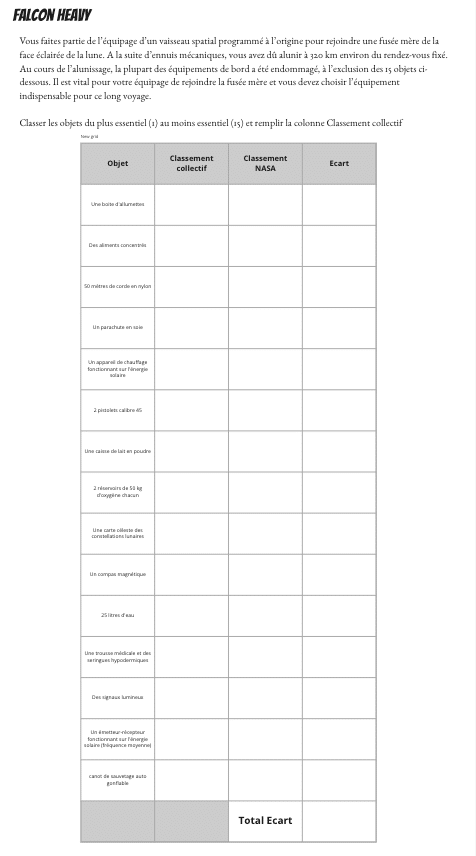
Animation
On lance un chrono de 15 minutes pour donner un cadre de temps aux différentes équipes.
En tant qu’animateur, notre rôle est principalement d’observer et d’écouter la dynamique du groupe. En effet, l’idée est de laisser le groupe se construire afin que l’expérience de ses membres soit authentique. Cependant, on pourra les inviter à discuter de leurs modes de prise de décision si nécessaire.
L’exercice se déroule de manière plutôt fluide et il est intéressant de voir des personnalités se révéler pendant les échanges. Cela n’est probablement pas une nouveauté mais les serious games ont cette force de faire émerger les automatismes. La difficulté est de prendre le recul nécessaire pour s’observer soi et les autres et d’en tirer des apprentissages.
Voici à quoi ressemblait le support de débrief avec toutes les équipes :
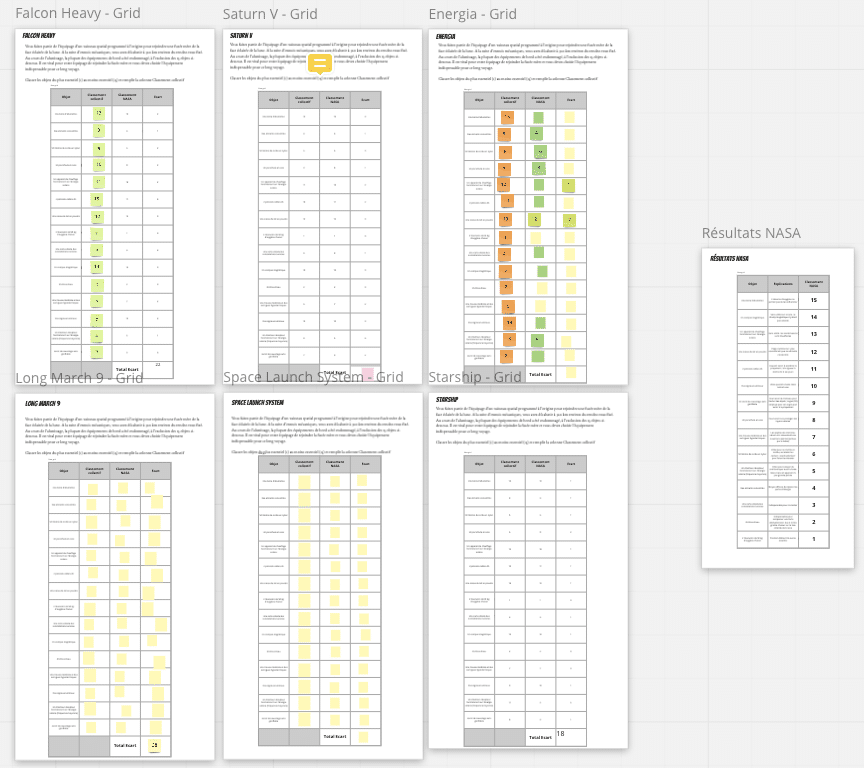
On peut voir que chaque équipe a rempli le tableau à sa manière ! 😛
Lorsque le temps est écoulé, nous invitons chaque équipe à revenir dans la salle principale pour leur partager les résultats de la NASA. Dans le même temps, on leur demandera de remplir la colonne correspondante et de calculer leur écart de résultats. Le plus petit écart déterminera l’équipe gagnante ! 😉
Débriefing
Enfin, nous ouvrons la conversation autour des thématiques :
- de la dynamique du groupe,
- des modes de prise de décision,
- du leadership ponctuel qui aurait pu émerger au sein des équipes.
L’échange est convivial mais il semble difficile pour les participants d’exprimer les difficultés en public, la distance n’aidant probablement pas à créer un environnement suffisamment sécurisé.
Mais cela est ok, l’idée n’était pas d’aller trop en profondeur. On cherche plutôt à créer de la curiosité, de l’ouverture et une expérience commune que l’on pourra réutiliser à l’avenir.
Règles de fonctionnement
Dans cette dernière séquence, on propose aux participants de structurer cette communauté selon certains critères. On utilise le même principe que pour l’ice-breaker, cela crée de la cohérence et accélère la mise en mouvement des participants.
Durée et Fréquence
Nous avions proposé une durée d’1h30 par défaut :
- 1h apparaissait trop courte en prenant en compte les retards du départ, les 2 séquences (expérientielle et structurelle) et le débriefing.
- 2h apparaissaient trop longues 😛
La question qui se posait alors à ce moment :
Maintenant que vous avez une idée de ce qu’il peut se passer pendant ce moment, quelle couple durée / fréquence vous semblerait le plus adapté ?
– Question Durée / Fréquence

Le résultat nous envoie donc vers une fréquence mensuelle, la durée oscillera entre 1h30 et 2h. Cela est un bon signe, on peut se dire que les personnes n’ont donc pas perdu leur temps ! 🙂
Thématiques
On questionne ensuite les participants sur le contenu qu’ils aimeraient avoir pendant cette rencontre. En effet, je rappelle que c’est un moment qui n’est pas obligatoire et qui mérite donc d’avoir de la valeur pour eux. Sinon, cela risque de se transformer en une réunion supplémentaire, contraignante et frustrante pour tout le monde.
Toutes les réponses sont bonnes à prendre et les post-its se multiplient rapidement sur le tableau. Mes co-animateurs s’activent pour réorganiser en live les idées nous permettant plus facilement de distinguer les tendances.

Il en ressort alors différents éléments :
- Des retours d’expérience de projets
- Des ouvertures sur de nouvelles pratiques (outils / méthodes)
- Des présentations de métiers car tous ne sont pas connu de… tous ! 😛
Il est intéressant de voir ici le vis ma vie. En effet, c’est une dimension qui pousse à sortir de son carcan pour aller voir ce qu’il se passe chez les autres et découvrir leurs contraintes.
On rentre bien dans notre intention de partage et d’entraide qui commence sûrement par une meilleure compréhension de l’autre. J’espère que cela permettra dans la durée de meilleures interactions transverses.
Public
Pour ce kick-off, nous avions décidé d’inviter toutes les personnes participant de près ou de loin à la transformation Agile de l’entreprise. Cependant, cela ne représentait pas l’ensemble de la structure.
Après cette première session vécue ensemble, la question était de savoir ce que les participants pensaient du nombre de personne invitées et de la dynamique créée.
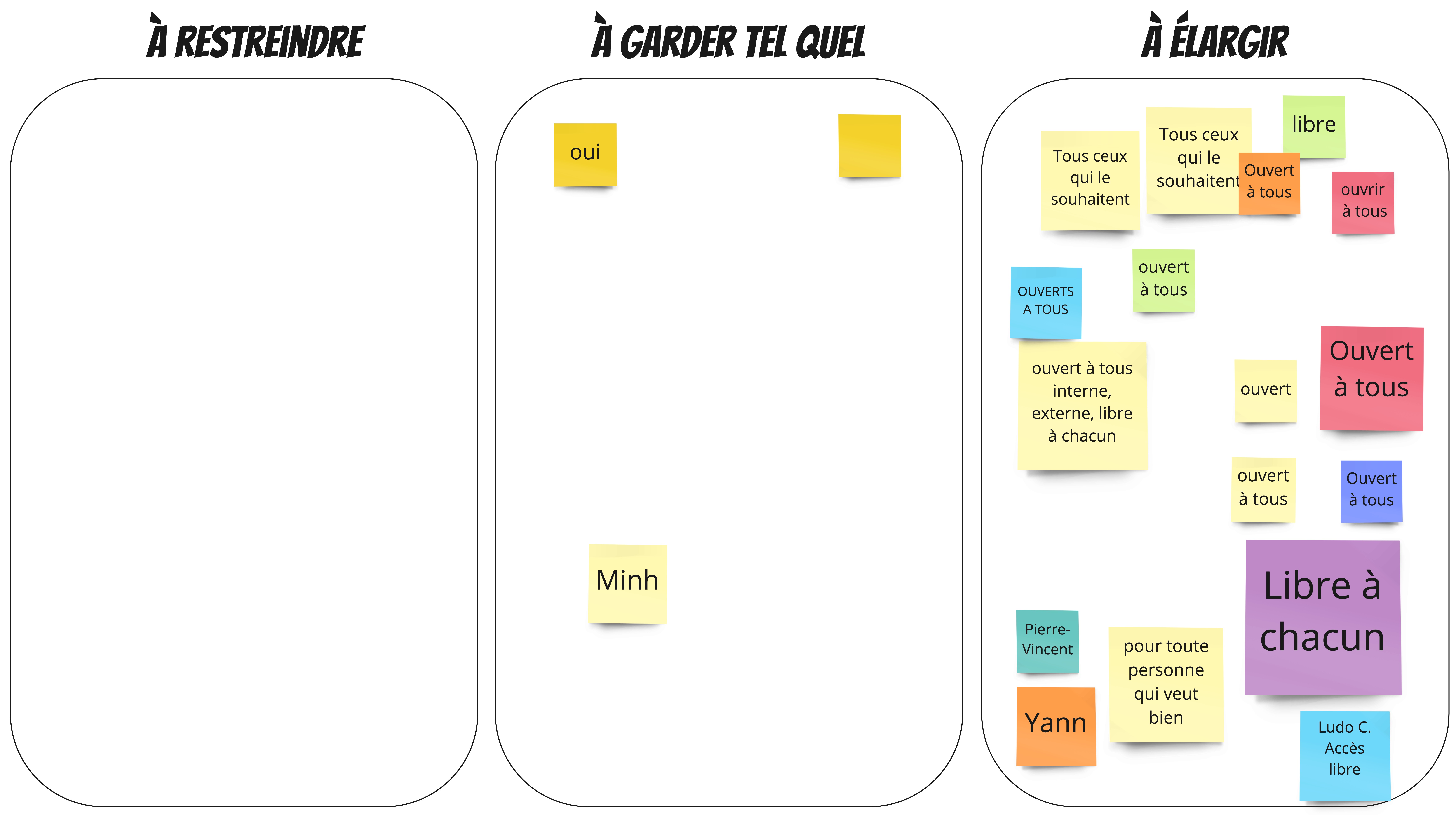
Avec un soupçon de surprise, le résultat qui émerge est d’élargir cet événement à qui souhaiterait y participer.
Je disais avec un soupçon de surprise car les événements qui réunissent un grand nombre de personnes (ici une quarantaine), pendant 1h30, à distance, et qui intéressent tout le monde sont rares. J’aurais donc naturellement pensé que la réponse serait de restreindre pour être plus focalisé.
Mais la preuve que non, pour le moment ! 🙂
Valeurs
Nous n’avions ici plus beaucoup de temps pour définir des règles de fonctionnement plus détaillées. Cependant, il me paraissait important de donner une couleur à la communauté, une certaine identité.
C’est pourquoi j’ai proposé de discuter des valeurs que devraient incarner cet communauté. Cela permettrait de donner une direction non seulement sur le fond mais également sur la forme !
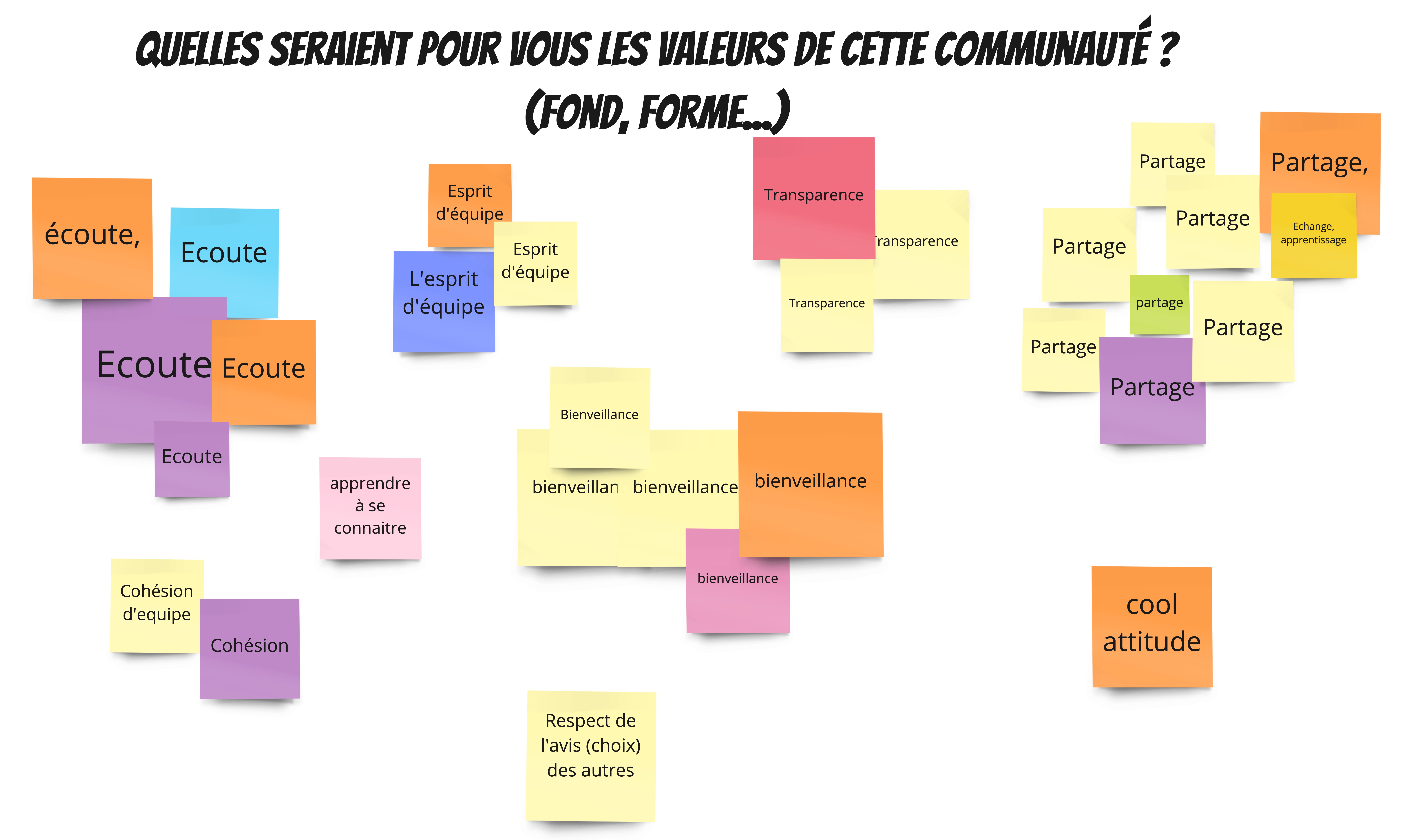
Les mots qui émergent ne sont pas tellement surprenants.
Au delà des buzzwords de la bienveillance et de la transparence, on voit bien que ce moment répond bien à un besoin : celui de se connecter aux autres pour créer un collectif plus soudé, dans le respect des idées de chacun. En effet, la crise sanitaire actuelle et le télétravail n’a pas aidé à maintenir les liens entre les personnes.
Ainsi, cette communauté pourrait alors devenir cet espace connecteur. Un lieu où les bonnes personnes auraient les bonnes conversations au bon moment.
Mot de la fin
Pour terminer et jauger de la pertinence de cette session, on demande à l’ensemble des participants de partager un dernier mot. L’occasion d’avoir une idée de ce avec quoi les personnes repartent.
Les autres facilitateurs et moi-même sommes déjà surpris de voir que sur les 45 connectés du départ, 40 personnes sont encore présentes. Cela est un point déjà extrêmement positif pour une « réunion non obligatoire ».
Maintenant, quelles en sont les véritables raisons ? Nous ne le savons pas, mais le fait est là ! 🙂

Des mots qui font chaud au coeur et qui donnent de l’énergie pour continuer ! Les participants semblent avoir passé un bon moment et semblent enclin à revenir la prochaine fois ! Bonne nouvelle 🙂
En plus de cela, nous terminons tout pile à l’heure. Un détail important pour moi pour montrer l’exemple. En effet, l’atelier était dense mais la facilitation a permis de garder un rythme soutenu mais confortable pour terminer dans la timebox définie !
Enfin, je retiendrais tout particulièrement les termes « pétillant » et « surprenant » qui valident le style d’animation que l’on a souhaité proposer et qui je l’espère fut apprenant.
Conclusion

Pour conclure, je pense que nous avons réussi à proposer un moment à la fois convivial et apprenant. Ensemble, ils ont pu posé les premières briques de structure de leur communauté. Cette dernière apprendra en marchant et affinera au fur et à mesure son mode de fonctionnement.
La prochaine étape sera de co-construire la prochaine session avec des membres de cette communauté. En effet, pour durer, c’est un moment qui doit avoir de la valeur pour eux autant sur le fond que sur la forme. Et c’est notre rôle de les y aider ! 😉
Je resterai toujours épaté de la puissance de la co-construction sur l’énergie et l’engagement des personnes. En transformant les injonctions en invitations, on donne l’espace à chaque personne pour s’exprimer, en Responsabilité, et pour créer des relations plus saines et plus sereines.
Et vous, qu’en pensez-vous ? 🙂






